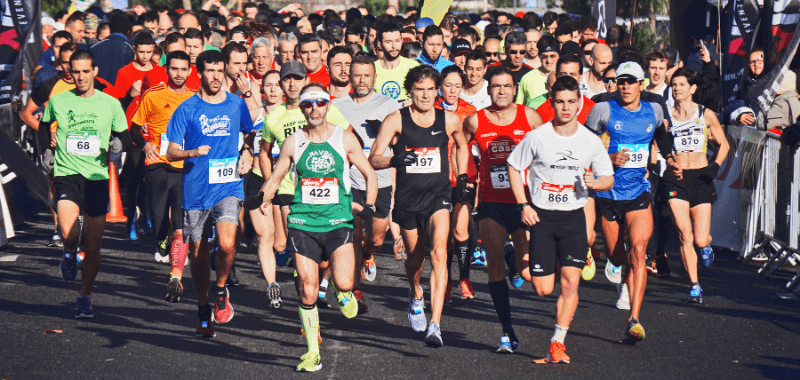Anteriormente, hablé de cómo la música mejora el rendimiento deportivo al actuar sobre ciertas áreas del cerebro y estimular la producción de ciertas sustancias que pueden provocar, entre otros efectos, el retraso de la percepción de fatiga. Sin embargo, todos sabemos que escuchar ciertos géneros musicales o ciertas canciones durante la actividad física no causan esta mejora en el rendimiento y a veces una canción que hace magia en nosotros no funciona para un compañero de entrenamiento. Entonces surge la pregunta, ¿Qué hace que una canción funcione?
Cualquier canción o composición musical se compone de cinco elementos que están bien organizados. Estos cinco elementos principales son: melodía, armonía, ritmo, tempo y dinámica.
- Melodía es una sucesión de notas que usualmente podemos tararear o silbar. En las canciones que tienen liricas, este elemento se encuentra en la sucesión de notas sobre las cuales se entonan las letras.
- Armonía, está compuesta por varias notas tocadas al mismo tiempo, en forma de acorde, que establece el estado de ánimo de la canción y puede hacer que el oyente se sienta feliz, triste, conmovido y romántico.
- Ritmo implica la distribución de las notas y la forma en que se acentúan.
- Tempo es la velocidad a la que se reproduce la música y que mide en beats por minuto (bpm). Se suele recomendar usar canciones con bpm entre 120 y 145 para correr.
- Dinámica tienen que ver con la energía transmitida por el músico.
De todos los elementos que componen una canción, el tempo es el más importante y, junto con el ritmo, son los elementos que tienen más probabilidades de generar una reacción física en el oyente. El ritmo va a ayudar al oyente a coordinar sus movimientos con la música, mientras tempo va a establecer la velocidad a la cual se realizarán.
La selección musical, por lo general, se produce después de considerar, consciente o inconscientemente, dos factores: los factores internos y externos. Los elementos que componen una canción y que se refieren a cómo se compone esta, como la Respuesta Rítmica y la musicalidad, se consideran factores internos. Las asociaciones extra-musicales y el impacto cultural de una determinada canción, se consideran factores externos ya que se refieren a cómo se interpreta la canción. Las liricas juegan un papel importante en la motivación musical, por lo tanto, si hay una mayor identificación con la letra o con la perspectiva del cantante, habrá una respuesta emocional más fuerte y el oyente se sentirá más motivado al escuchar la canción.
Dependiendo de qué tipo de entrenamiento se realizará, algunas canciones serán más adecuadas que otras. Por ejemplo, cuando se realizan ejercicios cuya actividad es constante y rítmica, como montar en bicicleta o correr, canciones con un bpm alto y pocas o ningunas variaciones de intensidad son mejores que las canciones que tienen muchas variaciones de intensidad y ritmo y un bpm alto. Estas canciones son mejores para los ejercicios en los que se realizan actividades explosivas, tales como levantamiento de pesas o rutinas de velocidad o intervalo, sea de carrera o de bicicleta.
Prueba esta playlist en un entrenamiento de intervalos o velocidad, corriendo más rápido en las variaciones de ritmo y dinámica de las canciones. Por ejemplo, prueba correr más rápido en los coros y recuperar durante los versos de las canciones, que suelen ser más lentos.
________________________________
Previously, I talked about how music improves athletic performance by acting over certain areas of the brain and stimulating the production of certain substances that could, among other effects, delay the perception of fatigue. However, we’ve all know that listening to certain music genres o songs during exercise do not cause this enhancement on performance, and sometimes a song that works magic on us doesn’t work for a training partner. So the question arises, what makes a certain song work?
Any song or musical composition is made up of five elements that are well organized. These five primary elements are: melody, harmony, rhythm, tempo and dynamics.
- Melody is the tune of a song that we can usually hum or whistle along. In songs that have lyrics, the melody is that tune to which the lyrics are sung.
- Harmony is the element, made up of several notes played at the same time as chords, that sets the mood of the song and can make the listener feel happy, sad, soulful or romantic.
- Rhythm involves the distribution of notes and the way in which they are accented;
- Tempo is the speed at which music is played and it’s measured in beats per minute (bpm). Try songs between 120 and 145 beats per minute (bpm).
- Dynamics have to do with the energy transmitted by the musician.
Of all the elements that make up a song, tempo is the most important and, along with rhythm, these are the elements that will most probably generate a physical reaction in the listener. Rhythm is going to help the listener coordinate its movements to the music, while tempo will set the speed of the movements.
Selecting music usually occurs after considering, consciously or subconsciously, two factors: Internal and external factors. The elements that make up a song and that relate to how a song is composed (Rhythmic Response and Musicality) are considered internal factors. External factors, such as extra-musical associations and cultural impact of a certain tune are considered external factors and they relate to how the song is interpreted. Lyrics play an important role in musical motivation, therefore if there’s a higher identification with the lyrics or the singer’s perspective, there will be a stronger emotional response and the listener with feel more motivated with the song.
Depending on what kind of workout will be performed, certain songs are more suitable than others. For example, when performing steady and rhythmic activities, such as cycling or running, songs with high bpm and few variations in intensity are better than songs that have lots of intensity and rhythmic variations. These songs are better for explosive activities such as weightlifting of speed or interval running.
Try this playlist for speed or interval training, running faster as the song’s rhythm and dynamics variations. For example, try running faster during de chorus of the songs and recovering during the verses, that are usually slower.
[8tracks url=»http://8tracks.com/running_beats/running-beats-mix-3″ flash=»yes» ]
running beats mix #3
Duración/Length: 48 mins
1. Sacrilege – Yeah Yeah Yeahs (120.05 bpm) Calentamiento/ Warm-up
2. Entertainment – Phoenix (150.85 bpm)
3. Shut Up and Let Me Go – The Tint Tings (108.01 bpm)
4. Tony The Beat – The Sounds (128.18 bpm)
5. Under Cover of Darkness – The Strokes (100.00 bpm)
6. Fucken Awesome – Spiderbait (151.51 bpm)
7. Cold Hard B**** – Jet (131.06 bpm)
8. Sex on Fire – Kings of Leon (153.59 bpm)
9. Looking Hot – No Doubt (128.02 bpm)
10. Northshore – Tegan & Sara (107.09 bpm)
11. Lonely Boy – The Black Keys (83.62 bpm)
12. Synthetica – Metric (159.00 bpm)
13. Purgatory Blues – Juliette & The Licks (89.00 bpm)
14. Diet Mountain Dew – Lana del Rey (88.01 bpm) – Enfriamiento/ Cool Down
Más información, recomendaciones musicales y tips en @running_beats / More info, musical recommendations and tips at @running_beats
La App de 8tracks está disponible para iPhone y Android / The 8tracks App is available both for iPhone and Android.
También pueden escuchar el mix en Grooveshark – running beats Mix #3 / You can also listen to this mix at Grooveshark – running beats Mix #3
Fuente: Scientific American, Costas I. Karageorghis, Peter C. Terry. «Inside Sport Psychology» (210)
Foto: Photos.com

Licenciada en Comunicación Social de la Universidad Católica Andrés Bello (Artes Audiovisuales) y egresada del Taller de Arte Sonoro. Melómana y deportista de nacimiento. Ha practicado deportes como natación, fútbol, atletismo, beisbol y kickingball.









0 comentarios